Ælfgif-who? provides short biographies of early medieval English women every two weeks. Click on the podcast player if you’d like to hear this newsletter read aloud in my appealing Yorkshire accent.
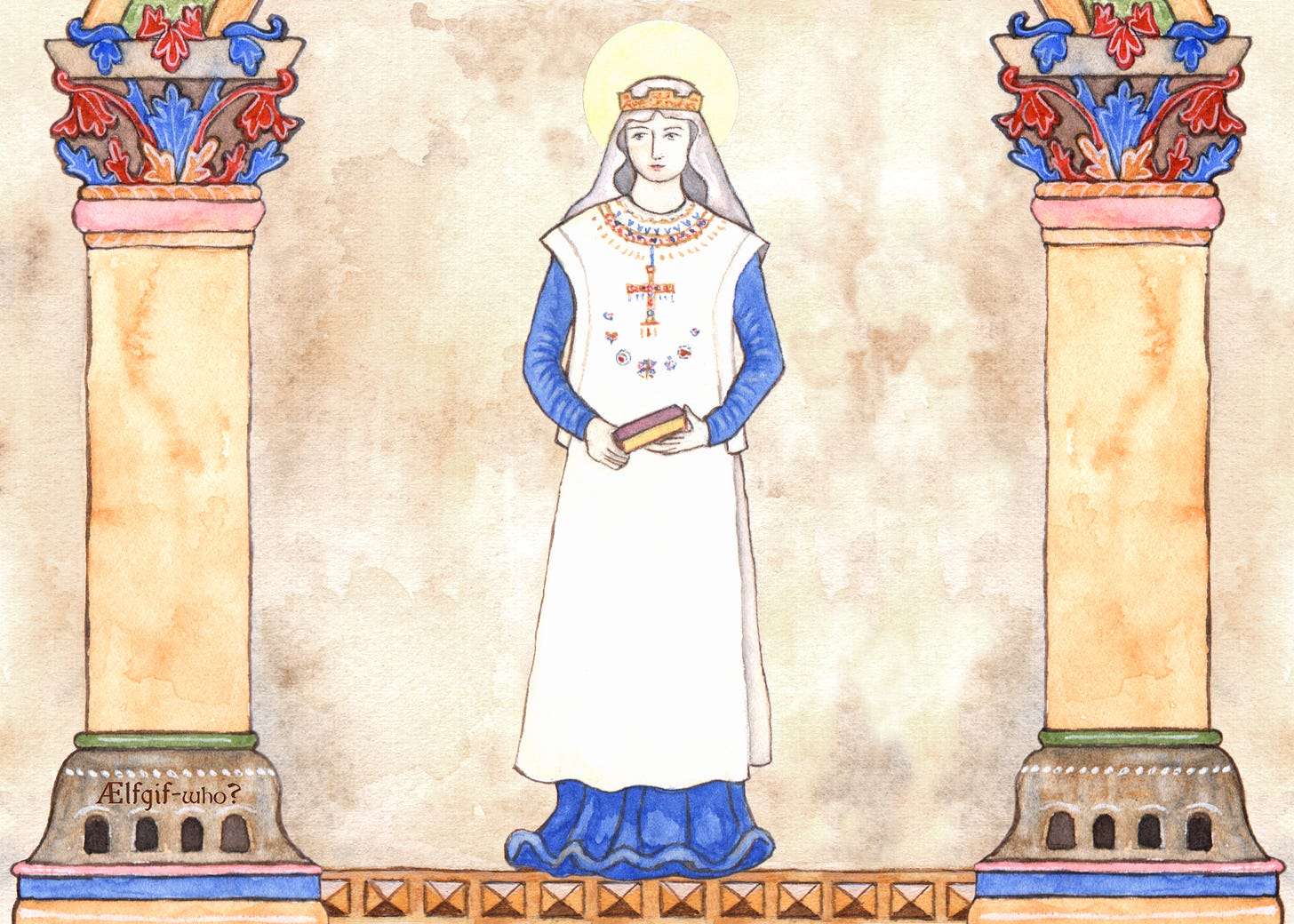
Balthild: From Enslaved Captive to Powerful Queen
Some Ælfgif-who biographies have been constructed around one main piece of historical evidence: Breguswith was mentioned by Bede in a single paragraph; Hugeburc is only known to us because she wrote her name in a secret cypher; we have the remains of the North Elmham and Fairford women but their stories have been lost.
Balthild, on the other hand, is probably the most attested seventh-century European woman. A saint’s life written about her soon after her death in 680 tells us her life story from her early life as an enslaved captive, to her rule as queen of Neustria, to her retirement at the abbey of Chelles. She is mentioned by no fewer than nine other sources. A number of objects survive that are associated with her, including a gold seal-ring which was found in Norfolk with the name ‘Baldehildis’ inscribed on it backwards. Relics stored at Chelles Abbey include several items of clothing, jewellery, and her bodily remains that reveal her height and hair colour. Though separated from us by over 1300 years, Balthild feels relatively close.
But even with all this evidence, Balthild is a complicated figure whose story is still contradictory and uncertain.
Early Life as an Enslaved Captive
We don’t know when or where Balthild was born. According to her hagiographer she was a Saxon, and she arrived in Francia from ‘lands across the sea’. From this detail we can deduce that she was English, as opposed to being from Saxony in Germany. She was ‘sold at a low price’, and acquired by the Mayor of the Franks, Erchinoald. She was apparently very beautiful, slender, dignified and pious, which Erchinoald found pleasing, and he made her his cupbearer. Her hagiographer praises the honour with which she washed and dried the feet of Erchinoald and his guests, she fetched their water, washed their clothes, and she did all of this without complaining! Despite Balthild having been sold to Erchinoald as an enslaved captive and forced to serve him, the hagiographer does nothing to criticise these circumstances, or her male captor, instead using it as opportunity to stress her dignity and virtue.
She was so virtuous that Erchinoald decided he wanted to marry her. Balthild hid herself in a pile of rags in the corner instead. While a modern audience might read this as an act of resistance, to avoid the trauma of being forced to marry her captor, the hagiographer casts it as an act of humility. Balthild simply wanted to remain a humble virgin rather than marry someone with high status. When Erchinoald miraculously couldn’t find her buried under rags in a corner of his own house, he married someone else. She was eventually found when it was too late, and by the will of God she came to marry King Clovis instead of Erchinoald - her humility and renouncing of status was rewarded with even higher status. The question of whether Balthild wanted to marry the king is not raised.
As as is often the case with saints’ lives, we must take this narrative with a large pinch of salt. The purpose of the hagiography is to make her the model of female saintly virtue, which involves casting her as lowly, humble, forbearing, and reluctant to marry for status. The hagiographer uses phrases taken from the Book of Esther, another queen who had lowly origins, to emphasise this narrative.
Narrative convenience aside, the idea of an enslaved English captive marrying a Frankish king is not unfeasible. The Franks did trade in captives from England in this period, and the Merovingian royal dynasty, of which Clovis was a part, often made low-status women their wives or concubines. However, the author of the Life is not specific about Balthild’s background. That she was a captive does not mean that she came from a low-status family: she may have been a noble or even royal captive. The Liber Historiae Francorum, an eighth-century anonymous chronicle, states that Balthild was from Saxon nobility. Moreover, it was rare to see low-born women, even those who were married to Merovingian kings, exercising the kind of power that Balthild would come to have - and a previously enslaved person doing so is unheard of. The discovery of a Frankish-style seal ring in Norfolk bearing the name BALDEHILDIS has been taken as evidence that she was from this area and of high status; indeed, her captor Erchinoald seems to have had contacts in East Anglia. However, this ring, which appears to depict Christ and a cross on one side and a man and woman having sex on the other, presents many more questions than answers. Did the ring belong to this Balthild? At what point during her career was it made? Why does it apparently depict a sexual encounter? Why would the ring be in a Frankish style, yet found in East Anglia? Is the ring really from the seventh century? None of these questions have been sufficiently answered.
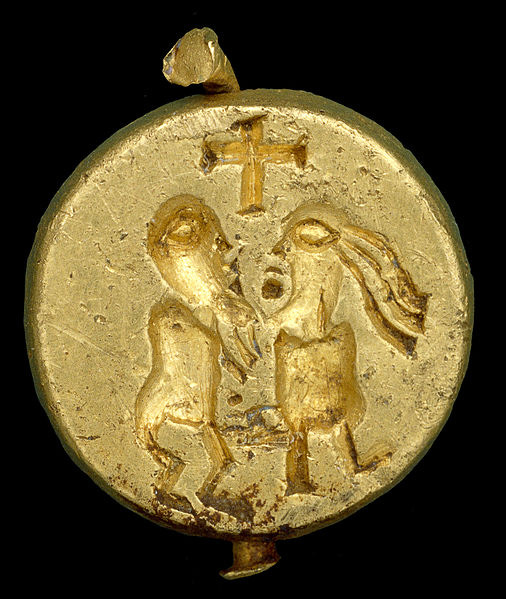
Queen of Neustria
Balthild’s husband, Clovis II, was born in 633, and was king of Neustria from the age of five. His father Dagobert had split the kingdom of Francia between his two sons: Neustria in the west for Clovis and Austrasia in the east for his younger brother Sigibert. Clovis married Balthild as soon as he was fifteen, though it is not known how old Balthild was.
Her hagiographer puts much emphasis on her royal offspring as the continuing royal line stemmed from her. She gave birth to three future kings: Clothar III, Theuderic III, and Childeric II. Despite being a mother and a married woman, her hagiographer is keen to stress that she still served the Lord through worship, charity and caring for the poor: she even had her own almoner, Abbot Genesius, who was in charge of distributing her donations.
After Clovis II died in 657 at around age 24, the young Clothar III inherited the kingdom of Neustria, while Childeric inherited Austrasia from his uncle Sigibert. The hagiography states that the installation of Childeric was instituted by Balthild. Balthild and the Sigibert’s widow queen, Chimnechild, arranged for the betrothal of their young children, who were first cousins. The Liber Historiae Francorum tells us that Balthild became regent for her young son Clothar, and although the Life does not mention this directly, it does describe Balthild’s involved role in the ruling of the kingdom. According to her hagiographer she stopped the practice of simony (paying to be made bishop) and quashed infanticide. She gave away much gold and silver, including her own belt. She donated royal lands to the church to construct monasteries, and had a huge nunnery built at Chelles, near Paris.
Perhaps most fittingly, Balthild apparently made it illegal for Christians to be kept as captives or traded in the kingdom of Neustria, and personally paid for many captives ‘of her own race’ (presumably enslaved people from England) to be freed or sent into monasteries.
However, while Balthild’s interference in church matters was presented as charitable by her hagiographer, it was seen differently elsewhere. In Stephen of Ripon’s Life of Saint Wilfrid, Balthild is accused of having had nine bishops put to death: this is repeated by Bede in the Ecclesiastical History. Stephen compares her to the ‘most impious queen’ Jezebel, and cites the case of Bishop Aunemund as an example of such a martyrdom. In fact, Aunemund, who gave Wilfrid patronage in his early ecclesiastical career, seems to have died as a result of a local conflict. Balthild’s complicity lies in having her own almoner, Genesius, replace him as the Bishop of Lyon. As Stephen has no other examples and a clear reason to dislike Balthild, we might be sceptical of this picture of her as a bishop murderer.
Retirement at Chelles Abbey and Sainthood
Conversely, according to her hagiographer, the Neustrian nobles killed a bishop called Sigobrand in an insurrection, against Balthild’s will, and were frightened of how she would react. Presumably Sigobrand was another bishop who Balthild had appointed into his role. As a result, Balthild was ‘permitted’ to retire to the monastery she’d had built at Chelles, though to what extent this retirement was voluntary is highly questionable. The Life describes her time at the monastery fairly predictably: she gave up her queenly power and lived a life of piety and humility, serving her sisters in the kitchen and even cleaning out the latrines. She became ill, and when her life was coming to an end she had a dream that she would ascend a staircase into heaven, to be crowned with an eternal reward. When she died on the 30th January 680, everyone at the monastery grieved her. There are reports of miracles at her tomb, including a boy being cured of demonic possession.
Her cult was established soon after her death, as her Life was written within a decade of 680. A number of relics associated with Balthild have survived. The most famous of these relics is her chemise, the front panel of a tabard that has been embroidered with necklaces and medallions in coloured silks. This garment probably represents Balthild’s transition from the luxury of queenship into a more monastic life. The Life of St Eligius reports that Eligius appeared to one of Balthild’s courtiers three times to warn Balthild to give up her gold jewellery. Apparently she obeyed, keeping only two gold bracelets. The chemise is a visual representation of the luxurious jewellery she used to wear, replaced with less lavish silk (though silk was still an imported luxury good) that may have been embroidered by Balthild herself.
In 1983 more relics were rediscovered at Chelles that are presumed to have belonged to Balthild. Among these relics, which are of the right date, are skeletal remains of a woman that show she was 5 feet tall, and even a plait of her hair survives - blonde, though greying. Other items include a pink and yellow silk semicircular cloak about 2.5 metres wide, a tiny brooch, and silk woven straps decorated with animals. For a woman who lived so long ago, we have an extraordinarily clear picture of what she might have looked like.
Finding Balthild
But while Balthild is extensively attested by both written sources and material finds, especially in comparison to other women from the same period, we still have to be very careful in reconstructing her life. There are a number of reasons for this caution. First, there are so many unknowns not covered by the source material, including her origins and background pre-slavery, and even her own perspective. Second, although we have a number of relics and archaeological finds that we can assume belonged to Balthild, including bodily remains, it is difficult to prove definitively. Third, the majority of written sources have clear and obvious biases. The Life of Balthild, though likely written by someone who knew her, is written purely to emphasise her sanctity, a process which inevitably involves relying on restrictive feminine tropes and suppressing her actual persona in favour of an ideal. The Life of Wilfrid, with its own agenda, presents a completely opposing picture of her as a murderous Jezebel. We have to accept that neither of these sources gives us a true picture of a real woman.
However, such contrasting depictions point to a controversial figure. Her interventions in politics, whether for good or for evil, and whether the reason for her downfall, were clearly extensive and disruptive. All the evidence points to the conclusion that Balthild was a figure who was at one point enslaved, but who went on to wield great power in her time as queen, so much so that she became a threat who had to be removed.
Interested in the medieval clothing mentioned here? If you haven’t already, consider becoming a paid subscriber to access all exclusive posts including a two-part post about what early medieval women wore:







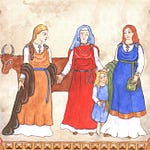
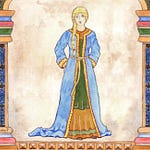
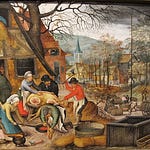
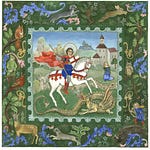



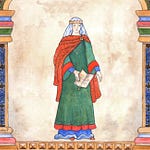
Share this post